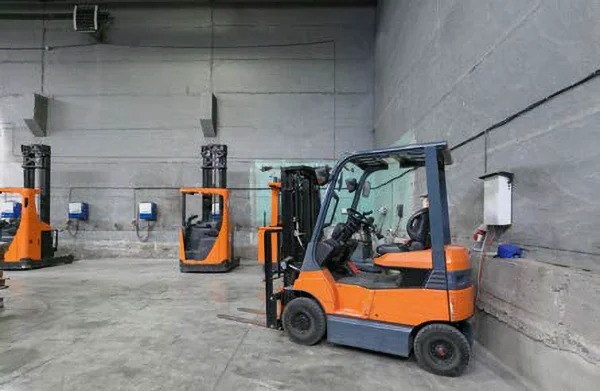Visit Green Cubes at HIMSS Global Health Conference & Exhibition 2026, Las Vegas, NV March 9-12,
Opportunity Charging
Opportunity charging is a practice applicable to both Lead Acid and Lithium-ion (Li-ion) batteries for motive power systems and especially useful for Material Handling (MH) equipment. Fast charging is a key differentiator for Lithium-ion batteries. Because the chemistry allows fast charging without damaging cycle life, our Lithium SAFEFlex Li-ion batteries can be charged opportunistically during breaks and don’t require battery swaps.
Green Cubes’ state-of-the-art Lithium SAFEFlex chargers employ high-frequency technology for the most compact, efficient for the widest voltage range available on the market today. Multiple outputs and automatic voltage detection via CAN communication enable simultaneous charging of multiple trucks with a single utility connection. The modular design allows an entire fleet, from pallet jacks to forklifts, to be serviced, opportunity charging around the clock.
Charging Li-ion Batteries
Li-ion batteries are preferably charged using a Constant Current / Constant Voltage (CC/CV) charge regime, but most MH equipment batteries are designed to accept both CC/CV and FLA charge regimens. Regardless of the state-of-charge of the battery when connected to the charger, the battery will efficiently accept the power and increase its state-of-charge. Whether the battery has been connected to the charger for 15 minutes or two hours, that battery can be immediately discharged and used by the MH equipment as there is no need to cool or rest a Li-ion battery after charging.

The Li-ion cell chemistry has numerous chemical variants. Lithium Iron Phosphate (LFP) chemistry is the predominant chemistry used to power MH equipment: LFP features:
- exceptionally long cycle life (2000 – 4000 cycles to reach 80% of the original capacity)
- high power capabilities for both charge and discharge
- lower energy/density than other Li-ion variants
The long cycle life means an LFP battery can be installed and remain in the equipment for 8-10 years. More importantly, since LFP chemistry can accommodate high power delivered to and from the battery, a depleted LFP battery can accept a full charge in a little over one hour (i.e. 1 C rate) and it can be delivered throughout the shift when the operator has a break or lunch. Li-ion is the optimal chemistry for opportunity charging.
Best Practices for Opportunity Charging
- Do a power study where the battery activity is monitored. Based on the data, one can determine whether there are adequate opportunities for charging throughout the shift. If there is no down-time for the equipment throughout the shift, then the batteries will need to be charged for an hour before the shift.
- Single shift vs. multi-shift operations can determine the value of opportunity charging. If the enterprise operates a single shift operation, a fully charged Li-ion (or FLA) battery should power that vehicle through the shift. When a second (or third) shift is needed, then opportunity charging can be used to recharge in increments and ensure that the equipment is powered through all the shifts.
- Rather than charging FLA batteries in a centralized battery maintenance room, distributed the Li-ion charging stations near break rooms and heavy work areas. Decentralized charging stations eliminate the operator’s travel time from their work area to battery maintenance room as well.
- Assess existing FLA chargers to determine if they are compatible with the Li-ion batteries.
- Assess the power output of the existing FLA and Li-ion charging infrastructure. The the power rating on the charger must be much higher when opportunity charging.
- Consider a multi-voltage battery if opportunity charging is desired but there is not adequate down-time within a shift .
Next Event
Latest News
Customer Ratings and Reviews
Green Cubes is a great company, great engineers, great product. That’s been kind of my number one go to [lithium] battery.
President Industrial Power Company
The thing I like about Green Cubes is that they have other lines of business outside of material handling batteries, they have been in the lithium world for a long time. I can trust they will likely stay in business
VP Industrial Battery Company
Green Cubes [differentiates] on its capability to custom design for things like the hardware, the firmware, and inverters. They also have economies of scale because they make battery systems for things like forklifts.
VP Powered Cart OEM
I am doing some work with them right now. We’re learning their products, and looking at demos. They have good people. They seem like they know the technology well – they say they’re a technology company. I like that they’ve been in the lithium business a long time. I can trust they will likely stay in business.
Sales Manager Industrial Battery Company
Green Cubes Technology would be my go-to for lithium applications.
Branch Manager OEM
I’ve told my friends at Green Cubes, I don’t plan on going anywhere. I believe in loyalty.
